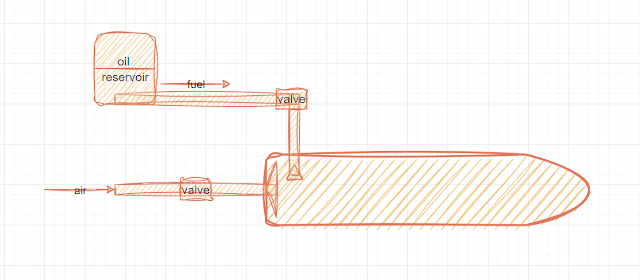This essay explores the concept of using siphoning as a fuel pump system, examining its efficiency, practicality, and potential benefits.
Below is the initial sketch for the burner. Fuel, in this case vegetable oil, is stored in a reservoir. It is then siphoned down a tube into an atomiser, which is then held in front of a stream of low speed, high pressure air. This mixes thoroughly with he oxygen and makes a mixture suitable for combustion. This is then lit by hot gases expelled from the mouth of the rocket, and then exits, creating thrust and massive amounts of heat.
The Siphoning Principle
Siphoning is a natural phenomenon that occurs when a liquid flows between two containers at different elevations due to the force of gravity.
It involves a tube through which the liquid moves, creating a vacuum that draws the liquid upward and overcomes the force of gravity. In the context of fuel burners, this principle can be harnessed to transport fuel from a storage tank to the burner unit without the need for mechanical pumps. It is essentially like pouring water, but simply down a tube.
Efficiency of Siphoning
One of the primary advantages of using siphoning as a fuel pump system is its inherent simplicity. Unlike mechanical pumps, which often require maintenance and can be prone to mechanical failures, siphoning relies on a basic understanding of physics. The absence of moving parts in a siphoning system reduces the risk of breakdowns, making it a potentially more reliable and efficient method for fuel transfer.Additionally, siphoning eliminates the need for external power sources, such as electricity or batteries, which are commonly required for mechanical pumps.
Practicality
The practicality of siphoning as a fuel pump system extends to various settings, including both industrial and domestic applications. In remote areas where infrastructure is limited, and access to electricity is challenging, siphoning offers a simple and viable solution for fuel transport. Its low maintenance requirements make it suitable for use in environments where regular servicing may be difficult to achieve.
Furthermore, the ease of implementation makes siphoning an attractive option for small-scale burners, such as those used in heating systems for homes or workshops. The absence of complex components simplifies installation and reduces the overall cost of the fuel delivery system.











